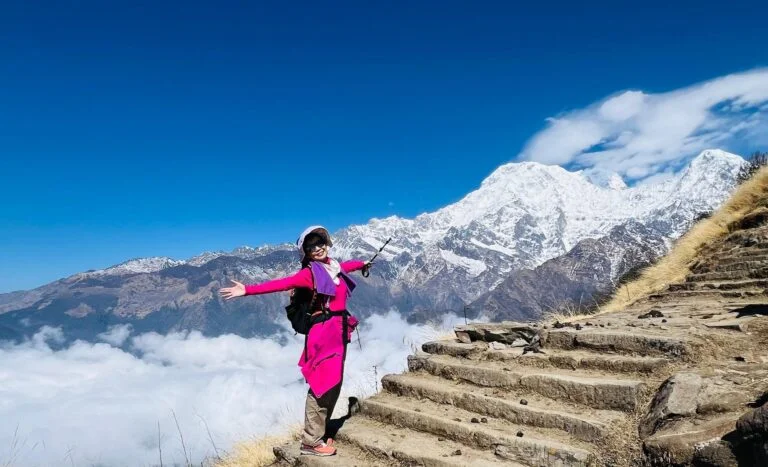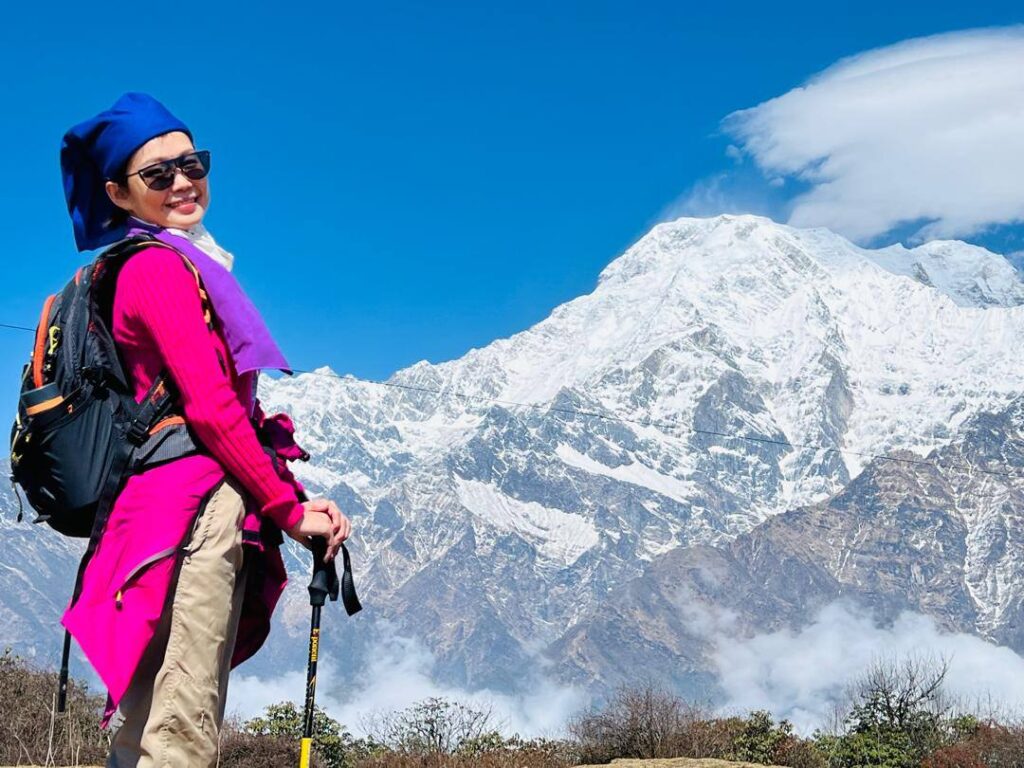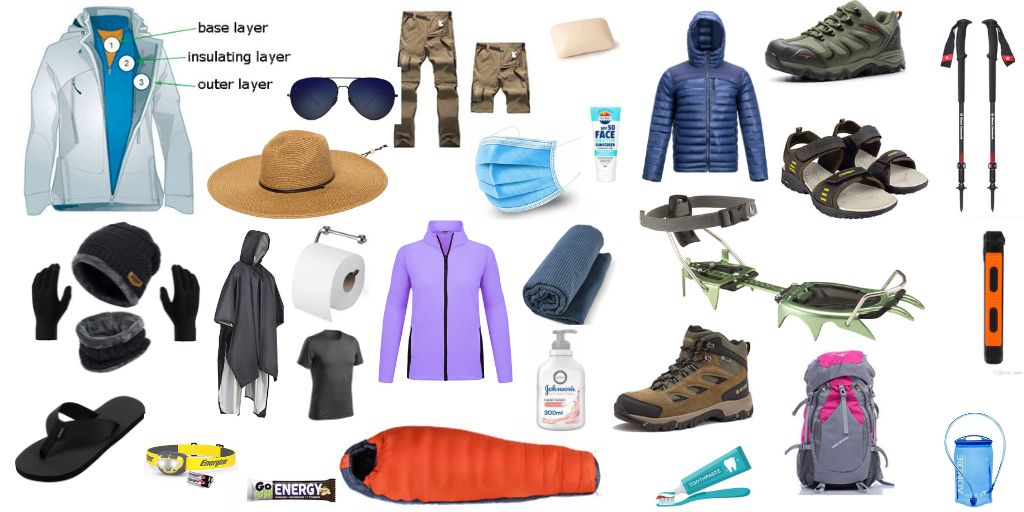Table of Contents
Weather on the Mardi Himal Trek

The Mardi Himal Trek is a hidden gem in Nepal’s Annapurna region, offering stunning views of snow-capped peaks, lush forests, and vibrant rhododendron blooms. Understanding the weather on the Mardi Himal Trek is crucial for planning a safe and enjoyable adventure. Each season—spring, autumn, summer, and winter—brings unique Mardi Himal Trek weather conditions, affecting trekking conditions Mardi Himal and the overall experience. This guide breaks down what to expect each season, with Mardi Himal trekking tips to help you prepare.
Spring Weather on the Mardi Himal Trek (March to May)

Spring is widely regarded as the best time to trek Mardi Himal due to its pleasant Mardi Himal temperature and vibrant landscapes. During March to May, the weather on the Mardi Himal Trek is mild, with daytime temperatures at lower altitudes (1,400–2,500 m) ranging from 10°C to 20°C (50°F to 68°F). At higher altitudes, such as Mardi Himal Base Camp (4,500 m), daytime temperatures range from 5°C to 15°C (41°F to 59°F), while nights can drop to -5°C to 5°C (23°F to 41°F).
- Highlights: The rhododendron bloom Mardi Himal transforms trails into a riot of red, pink, and white colors, perfect for nature lovers and photographers. Clear skies offer breathtaking views of the Annapurna and Machhapuchhre peaks.
- Mardi Himal rainfall: Occasional light showers are possible, so pack rain gear to stay dry.
- Mardi Himal trail conditions: Trails are generally dry and in excellent condition, though spring’s popularity means busier routes. Pre-book accommodations to avoid crowds.
- Mardi Himal trekking tips: Wear light layers during the day and a warm jacket for cooler nights. A waterproof jacket and sturdy trekking boots are essential for Mardi Himal altitude weather changes.
Spring’s moderate Mardi Himal Trek weather makes it ideal for trekkers seeking vibrant scenery and comfortable trekking conditions Mardi Himal.
Autumn Weather on the Mardi Himal Trek (September to November)

Autumn is another best time to trek Mardi Himal, known for stable weather on the Mardi Himal Trek and crystal-clear skies. From September to November, daytime temperatures at lower altitudes range from 10°C to 15°C (50°F to 59°F), while at Mardi Himal Base Camp, they reach up to 16°C (61°F). Nighttime temperatures can drop to -5°C (23°F) or lower at higher elevations.
- Highlights: Post-monsoon rains clear the air, offering unobstructed views of the Annapurna, Dhaulagiri, and Machhapuchhre peaks. The Mardi Himal trail conditions are stable, with minimal Mardi Himal rainfall.
- Mardi Himal temperature: Mild days and chilly nights require layered clothing, especially at higher altitudes.
- Crowds: Autumn is a peak season, so expect more trekkers on the trail. Book teahouses in advance.
- Mardi Himal trekking tips: Pack a warm sleeping bag, fleece jacket, and windproof layers for Mardi Himal altitude weather. Sunglasses and sunscreen are crucial for bright, sunny days.
The autumn weather Mardi Himal is perfect for those prioritizing clear mountain views and comfortable trekking conditions Mardi Himal.
Summer Weather on the Mardi Himal Trek (June to August)

Summer coincides with Nepal’s monsoon season, making it the least favorable time for the Mardi Himal Trek. The weather on the Mardi Himal Trek during June to August is warm and humid, with daytime temperatures at lower altitudes ranging from 15°C to 25°C (59°F to 77°F). At higher altitudes, temperatures range from 5°C to 15°C (41°F to 59°F), with nights dropping to 5°C to 10°C (41°F to 50°F).
- Challenges: Frequent Mardi Himal rainfall leads to muddy and slippery Mardi Himal trail conditions, increasing the risk of landslides and injuries. Leeches and mosquitoes are common, adding discomfort.
- Highlights: Lush, green landscapes and fewer trekkers offer a serene experience. Teahouses may provide discounts during this off-season.
- Mardi Himal trekking tips: Pack waterproof clothing, raincoats, sturdy boots with good grip, and insect repellent. Check the Mardi Himal weather forecast regularly, as flights and trails may be disrupted by rain.
- Mardi Himal temperature: Warm days are pleasant, but humidity and rain can make trekking challenging.
While the summer weather Mardi Himal is not ideal, adventurous trekkers who don’t mind wet conditions can enjoy a quieter trail.
Winter Weather on the Mardi Himal Trek (December to February)

Winter brings cold and dry weather on the Mardi Himal Trek, transforming the region into a snowy wonderland. Daytime temperatures at lower altitudes range from 10°C to 20°C (50°F to 68°F), but at Mardi Himal Base Camp, they drop to 0°C to 10°C (32°F to 50°F). Nighttime temperatures can plummet to -10°C to -15°C (14°F to 5°F), especially above 3,500 m.
- Mardi Himal snowfall: Snow is common at higher altitudes, creating stunning but slippery Mardi Himal trail conditions. Some teahouses at higher elevations may close.
- Highlights: Quiet trails and pristine snowy landscapes offer a peaceful experience. Clear mornings provide crisp mountain views.
- Mardi Himal trekking tips: Pack heavy winter gear, including insulated jackets, thermal layers, gloves, and a warm sleeping bag. Crampons or microspikes may be needed for icy trails. Check the Mardi Himal weather forecast for snow updates.
- Challenges: Shorter daylight hours and extreme Mardi Himal altitude weather require careful planning and early starts.
The winter weather Mardi Himal suits experienced trekkers prepared for cold and snow, offering a unique adventure with fewer crowds.
Mardi Himal Packing List for All Seasons

To prepare for the variable Mardi Himal Trek weather, a well-planned Mardi Himal packing list is essential:
- Spring/Autumn: Lightweight trekking pants, moisture-wicking shirts, fleece jacket, waterproof jacket, warm sleeping bag, sunglasses, sunscreen, and sturdy boots.
- Summer: Raincoat, waterproof socks, quick-dry clothing, insect repellent, and anti-slip boots.
- Winter: Insulated jacket, thermal layers, gloves, hat, crampons, and a high-quality sleeping bag.
- General: Headlamp, first aid kit, water purification tablets, and a waterproof pouch for permits (ACAP and TIMS).
Always pack layers to adapt to Mardi Himal altitude weather changes and carry enough cash, as ATMs are scarce on the trail.
Faq’s
What is the best time to trek Mardi Himal?
The best time to trek Mardi Himal is during spring (March to May) and autumn (September to November). These seasons offer mild temperatures, clear skies, and stable trail conditions, ideal for enjoying the rhododendron bloom Mardi Himal in spring or crisp mountain views in autumn.
How cold does it get at Mardi Himal Base Camp?
At Mardi Himal Base Camp (4,500 m), temperatures vary by season. In spring and autumn, daytime temperatures range from 5°C to 15°C (41°F to 59°F), with nights dropping to -5°C to 5°C (23°F to 41°F). In winter, daytime temperatures can be 0°C to 10°C (32°F to 50°F), with nights as low as -10°C to -15°C (14°F to 5°F).
Does it rain a lot during the Mardi Himal Trek?
Mardi Himal rainfall is most significant during the monsoon season (June to August), with frequent showers and muddy trails. Spring may have occasional light showers, while autumn and winter are generally dry, making them preferable for trekking.
Is there snowfall on the Mardi Himal Trek?
Mardi Himal snowfall occurs primarily in winter (December to February) at higher altitudes above 3,500 m, including Mardi Himal Base Camp. Snow can make trails slippery, requiring crampons or microspikes for safety.
What should I pack for the Mardi Himal Trek weather?
Your Mardi Himal packing list should include layered clothing for variable Mardi Himal altitude weather. Pack waterproof gear for summer, warm layers and a sleeping bag for winter, and lightweight clothing with a fleece jacket for spring and autumn. Sunglasses, sunscreen, and sturdy boots are essential year-round.
How Mardi Treks Will Help You
Mardi Treks, a trusted trekking agency in Nepal, ensures a seamless and safe experience on the Mardi Himal Trek by addressing the challenges posed by weather on the Mardi Himal Trek. Here’s how they support you:
- Expert Guidance: Mardi Treks provides experienced local guides who are familiar with Mardi Himal trail conditions and Annapurna region weather. They offer real-time advice on navigating weather changes, ensuring your safety during Mardi Himal rainfall or Mardi Himal snowfall.
- Tailored Itineraries: The agency customizes your trek based on the Mardi Himal Trek seasons and your preferences, recommending the best time to trek Mardi Himal (spring or autumn) or preparing you for off-season challenges like monsoon or winter conditions.
- Weather Updates: Mardi Treks monitors the Mardi Himal weather forecast and keeps you informed about potential disruptions, such as landslides in summer or icy trails in winter, helping you plan accordingly.
- Packing Support: They provide a detailed Mardi Himal packing list tailored to the season, ensuring you’re equipped for Mardi Himal temperature fluctuations, from warm days at lower altitudes to freezing nights at Mardi Himal Base Camp.
- Logistical Support: Mardi Treks arranges permits (ACAP and TIMS), books teahouses (especially crucial in peak seasons), and organizes transportation, allowing you to focus on enjoying the trek despite variable trekking conditions Mardi Himal.
- Cultural and Scenic Insights: Guides enhance your experience by pointing out highlights like the rhododendron bloom Mardi Himal in spring or sharing local knowledge about the Annapurna region, making your trek memorable regardless of the season.
With Mardi Treks, you’ll have a well-prepared adventure, equipped to handle the Mardi Himal Trek weather and make the most of this stunning trail. For bookings or inquiries, visit Mardi Treks or contact their team directly.
Final Thoughts on Mardi Himal Trek Weather
The weather on the Mardi Himal Trek varies significantly by season, impacting trekking conditions Mardi Himal and the overall experience. Spring weather Mardi Himal and autumn weather Mardi Himal offer the best conditions with mild temperatures, clear skies, and vibrant landscapes, making them the best time to trek Mardi Himal. Summer weather Mardi Himal brings rain and slippery trails, while winter weather Mardi Himal challenges trekkers with cold and snow but rewards with serene beauty.
Before embarking, check the Mardi Himal weather forecast and consult local guides for updates on Mardi Himal trail conditions. With the right preparation and Mardi Himal packing list, you can enjoy this breathtaking trek in any season. Whether you’re chasing the rhododendron bloom Mardi Himal or snowy vistas, the Mardi Himal Trek promises an unforgettable adventure in the heart of the Annapurna region weather.
